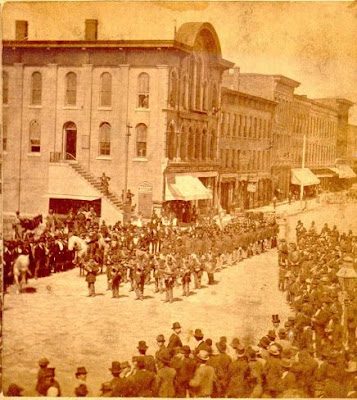As seen in the advertisement above, Dr. Aloys (sometimes spelled Aloysius) Szendery and his son Dr. Louis S. Szendery shared an office at 622 Adams Street in Sandusky, Ohio, which is now in the 100 block of East Adams Street, after the street numbering changed in Sandusky in 1915. The ad appeared in the April 10, 1885 issue of the Sandusky Register.
According to the Alumni Directory for New York University, Dr. Aloysius Szendery was born in Hungary in 1817. By 1860, Dr. Szendery and his wife Anna were residing in Bellevue, Ohio, where he worked as a doctor. They were the parents of four children. The oldest child, Louis S. Szendery, followed his father into the medical field. sadly, by the early 1890s, the younger Dr. Szendery faced serious health issues. He moved to Texas in hopes of his health improving, but he died there in 1896, leaving behind his wife, the former Elizabeth Westerhold, and a young son, Louis E. Szendery. Dr. Louis S. Szendery was only aged 36 at the time of his death.
Dr. Aloysius Szendery passed away at the age of 81 years and 11 months on August 31, 1898. An obituary from the September 1, 1898 issue of the Sandusky Register reported that Dr. Szendery was one of Sandusky’s oldest and well respected citizens. He was widely known, especially among the German residents of the community. During the last ten years of his life, the elder Dr. Szendery was totally blind. His funeral was held at Sts. Peter and Paul Church, and burial was at St. Joseph’s Cemetery in the family lot. A modest tombstone for the elder Dr. Szendery reads simply “Father.”
Anna Szendery, a daughter of Dr. and Mrs. Szendery, lived in Buffalo at the time of her father’s death. She died there in 1942, following a teaching career that spanned over fifty years at the Nardin Academy, which is affiliated with the Daughters of the Heart of Mary.
Louis Eugene Szendery, a grandson of Dr. Aloysius Szendery, and son of Dr. Louis S. Szendery, was trained as a pharmacist. For a time he was in the pharmacy business with Jay Meek. You can barely read the words “Meek & Szendery” in this sign on a building on Decatur Street. (The building no longer stands.) The partnership of Meek & Szendery was in business in Sandusky from 1916 to 1921. Louis E. Szendery eventually left his pharmacist position and became a salesman for a pharmaceutical company.
Louis E. Szendery died in 1974, and is buried at Calvary Cemetery next to his wife Verna (Ringel) Szendery. The name Szendery was familiar in Sandusky for several decades. If you would like to learn more about your own ancestors in Sandusky and Erie County, visit the Sandusky Library Research Center, where many sources related to family history and local history are housed.

 this blog
this blog





















